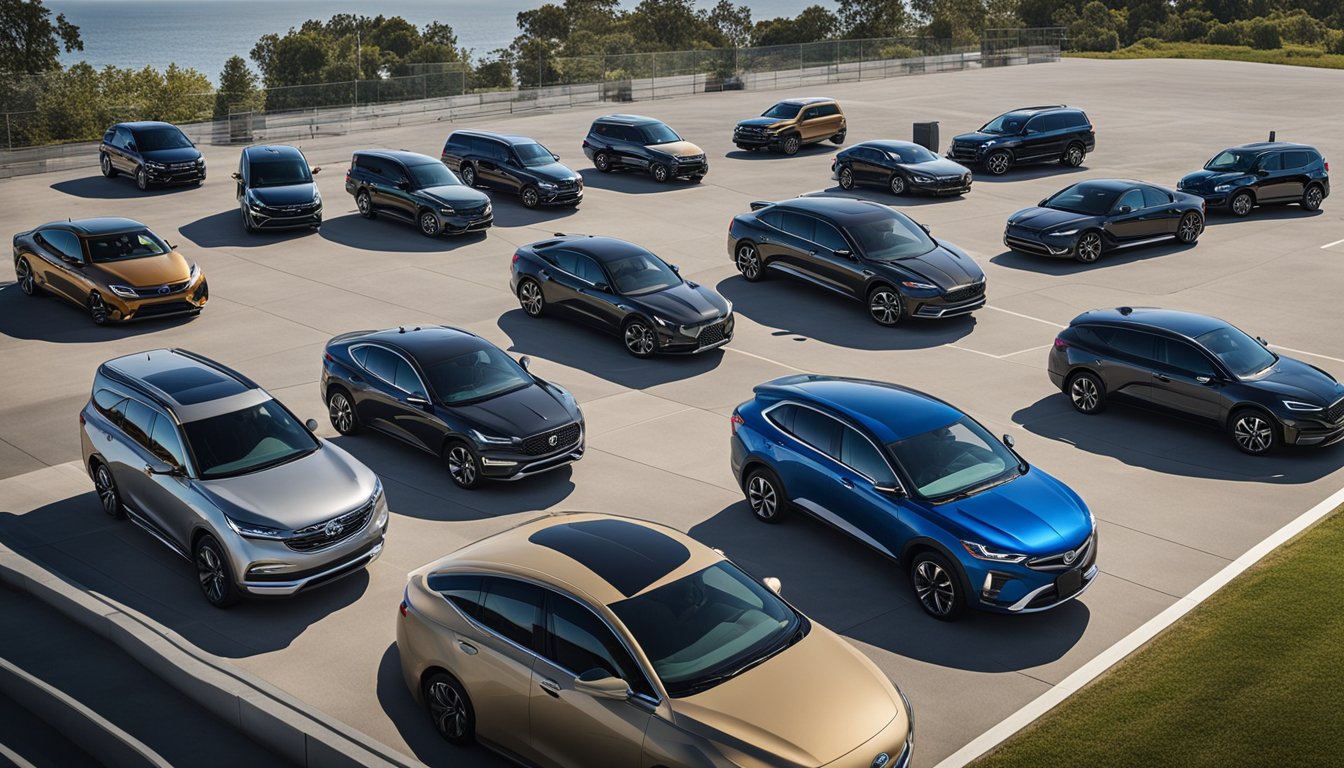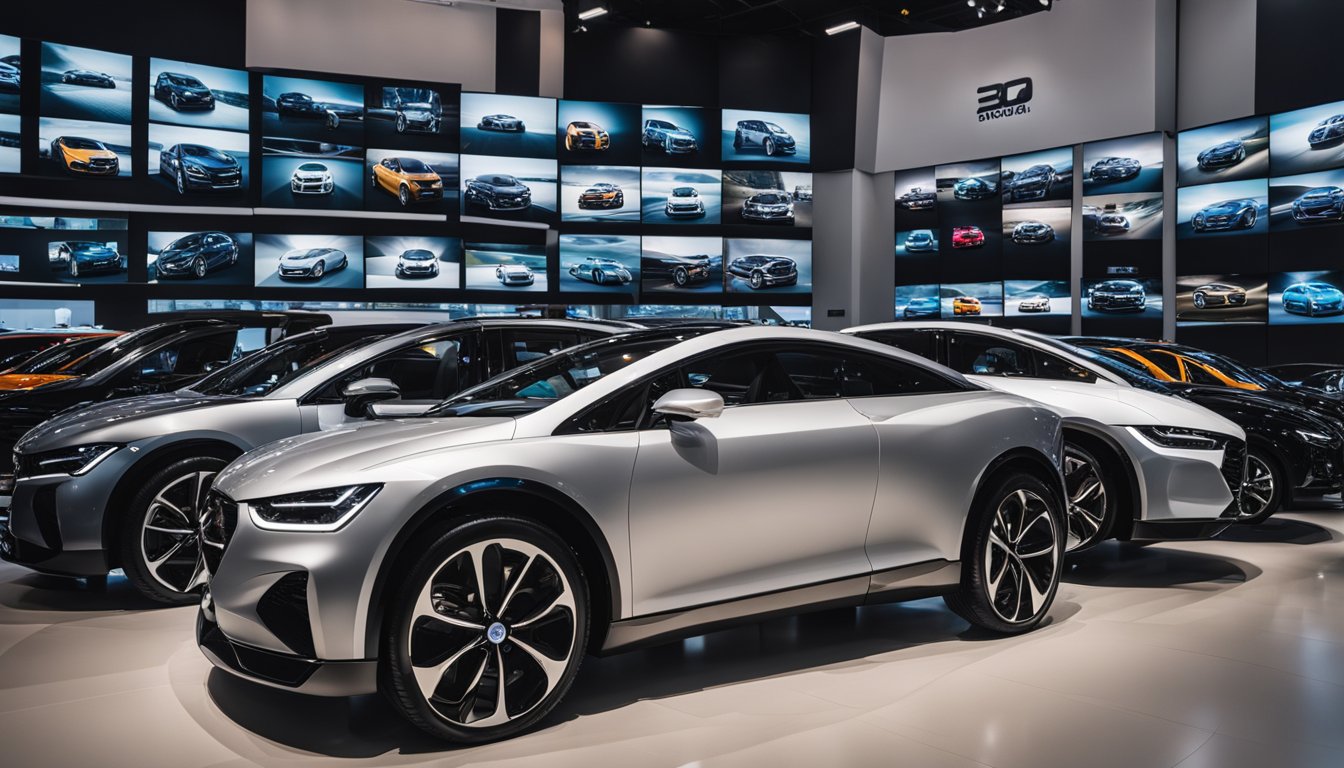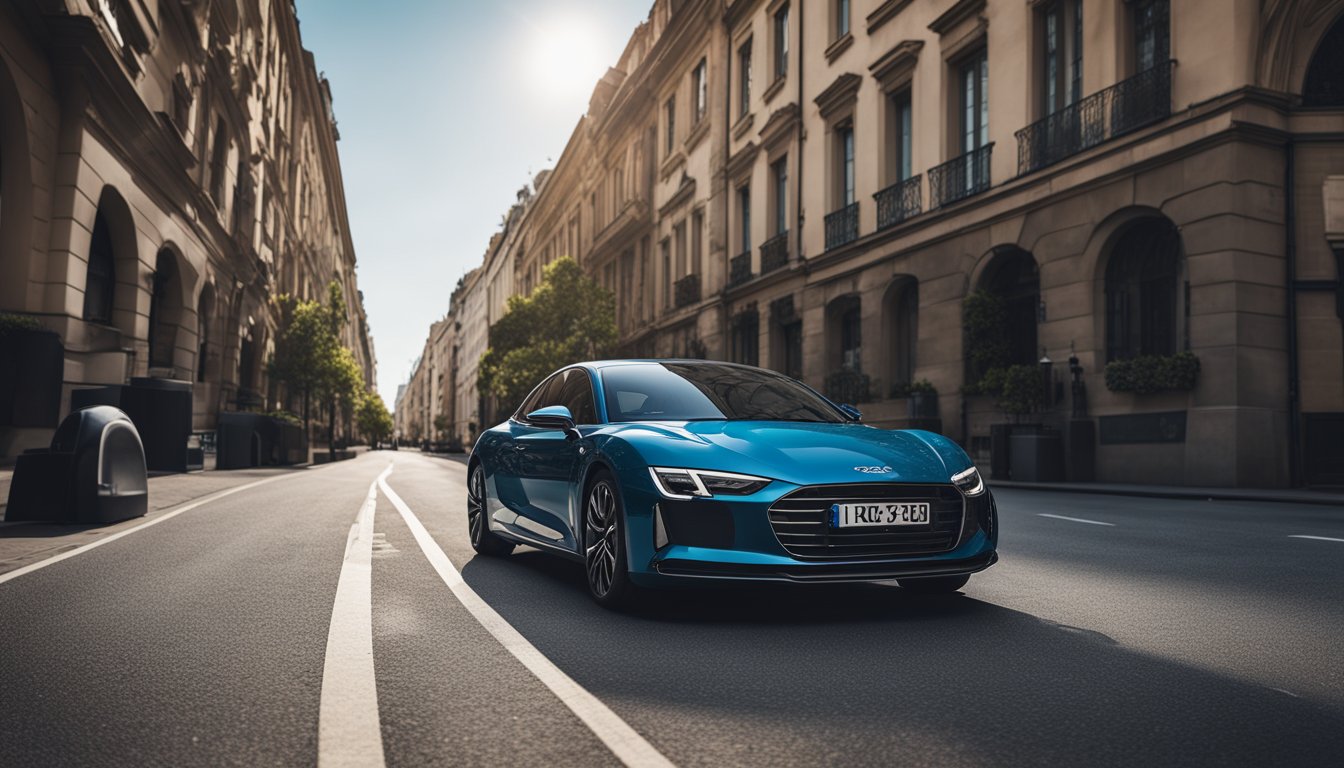As technology in the automotive industry evolves, 360-degree cameras have become a prominent feature in many vehicles. Offering a bird’s eye view of the surrounding area, this technology assists drivers in parking, maneuvering in tight spaces, and navigating busy roads with greater awareness. The convenience and added safety that 360-degree cameras bring to the driving experience make them a sought-after feature for new car buyers.
Understanding the functionality and availability of 360-degree cameras is crucial when looking for a new vehicle. These systems use multiple cameras positioned around the car to stitch together a comprehensive overhead image displayed on the vehicle’s infotainment screen. With the increase in demand, a range of models equipped with this technology are emerging, from family-friendly SUVs to luxurious sedans, bringing this advanced feature to a wide audience of automotive consumers.
Key Takeaways
- 360-degree cameras enhance parking and driving safety.
- Many new car models include this technology.
- These camera systems contribute to vehicle value and insurance aspects.
Understanding 360-Degree Camera Systems in Cars
https://www.youtube.com/watch?v=fdDZaH8hg1A&embed=true
360-degree camera systems in cars, often known as surround-view monitors or bird’s eye view cameras, provide you with a comprehensive visual of your vehicle’s surroundings. This technology stitches together images from multiple cameras placed around the car to create a single, cohesive real-time view displayed on the car’s infotainment screen.
Here’s a brief rundown on this handy feature:
- Technology: Advanced software combines the feeds from four to six exterior cameras.
- Safety: Enhances driving safety by minimizing blind spots.
- View Camera: Cameras are usually located at the front, rear, and sides of the vehicle.
The main components of the 360-degree camera system include:

- Front and Rear Cameras: Positioned to capture the view directly ahead and behind.
- Side Cameras: Installed beneath side mirrors or on the car’s flanks for a lateral view.
Benefits:
- Complete View: Offers a top-down perspective of your car and immediate surroundings.
- Parking Aid: Especially useful when navigating tight parking spots.
- Maneuvering in Traffic: Helps to identify nearby objects that might be out of your direct line of sight.
By utilizing this technology, you gain a level of awareness that can make all the difference in tight spots and busy lots, turning challenging maneuvers into a more manageable task. As the systems continue to improve, expect to see this feature become a mainstay in both new and high-end car models, adding an essential layer of security that matches with modern driving demands.
Benefits of Having a 360-Degree Camera
https://www.youtube.com/watch?v=X38sjawXo0I&embed=true
In today’s bustling world, your vehicle’s features can make all the difference, especially when it comes to safety and convenience. A 360-degree camera is one such feature that enhances your driving experience, offering both peace of mind and support in tight spots.
Enhanced Safety and Vehicle Handling
A 360-degree camera can significantly boost your vehicle’s safety by providing a bird’s-eye view of your surroundings. It integrates images from multiple cameras around your car to display potential hazards. This feature, combined with rear parking sensors, helps in detecting obstacles you might not see through the mirrors alone, enhancing your handling capabilities.
Easier Parking and Maneuvering
« Best 360 Cameras Under $100: Affordable Options for Immersive Photography
Best 360 Camera for Cars: Top Picks for Vehicle Surveillance & Safety »
You’ll find parking to be a breeze with a 360-degree camera as it eliminates blind spots and guides you into spaces with precision. The seamless view allows for better judgment and easier parking and maneuvering. Even in the tightest parking spots, your car’s parking sensors work alongside the camera to alert you about nearby objects, reducing the risk of collision.
Comprehensive View for Better Awareness
With a 360-degree camera, you’re equipped with a comprehensive view that standard backup cameras can’t provide. This full-circle perspective ensures that you’re aware of everything around your vehicle, offering a higher level of situational awareness and promoting safer driving practices. Whether you’re in a busy parking lot or on a narrow street, your awareness is significantly enhanced, giving you the confidence you need behind the wheel.
Popular Models with 360-Degree Cameras
https://www.youtube.com/watch?v=z5nARmJzfUc&embed=true
As you explore your options for a new car, you’ll notice that a 360-degree camera system is increasingly becoming a standard feature in many vehicles. Whether you’re looking at luxury brands known for their advanced technology or mainstream automakers focusing on value and safety, this feature adds convenience and peace of mind to your driving experience.
Luxury Brands
Lexus: The Lexus ES is not only elegant but also offers a high-definition 360-degree camera for superior visibility.
Audi: Opt for models like the Audi SQ5, where technology meets performance, with a top-down view to assist in tight spots.
Mercedes-Benz, BMW, and Acura are also at the forefront, integrating this camera system into their sophisticated safety packages across various models.
Infiniti: Infiniti’s luxury vehicles frequently come equipped with this desirable technology.
Jaguar and Land Rover: These British brands offer a combination of luxury and off-road capability along with 360-degree cameras.
Mainstream Automakers
Toyota: Models such as the Toyota Camry offer the 360-degree camera as an option on higher trims, enhancing their safety features.
Nissan: Nissan provides the Around View Monitor in many models, offering you a virtual bird’s-eye view.
Ford, Mazda, Chevrolet, Kia, and Volkswagen also include models in their lineups that feature 360-degree camera systems for improved driver visibility and aid in parking.
Hyundai: Known for packing value into their cars, Hyundai includes 360-degree cameras in select models.
Mitsubishi and Cadillac: Aim to enhance driver convenience by offering this technology.
Volvo: It emphasizes safety and includes a 360-degree camera system in some of its family-friendly vehicles.
RAM: Trucks from RAM have the option for 360-degree camera systems, providing a valuable tool for navigating tight spaces.
Comparison of 360-Degree Cameras by Vehicle Type
When you’re looking for a vehicle with top-notch visibility, 360-degree cameras can make a significant difference. Let’s take a look at how these cameras are integrated into different types of vehicles, so you can make an informed decision that suits your needs.
SUVs and Crossovers
- Toyota RAV4: With the Toyota RAV4, you can enjoy the safety feature of a bird’s-eye view camera, making parking and maneuvering in tight spaces much easier.
- Mazda CX-9: The spacious Mazda CX-9 is a family-friendly crossover that includes a 360-degree camera to enhance your safety and convenience.
- Hyundai Tucson: For extra security on the road, the Hyundai Tucson offers a surround view monitor that allows you to see everything around the vehicle.
- Mazda CX-5: Stepping up to the priciest trim, the Signature model of the Mazda CX-5 gets you not only luxury features like Nappa leather but also the sought-after 360-degree camera system.
Sedans
- Nissan Kicks: Compact yet equipped, the Nissan Kicks sedans offer a 360-degree view as a part of its intelligent mobility safety features.
- Hyundai Sonata: You’ll appreciate the surround view monitor in the Hyundai Sonata, which helps keep your sedan scuff- and dent-free.
- Toyota Camry: For those who favor a sedan, the Toyota Camry provides a comprehensive view of your surroundings with its own 360-degree camera system.
- Genesis G70: Driving the luxury-oriented Genesis G70 sedan comes with the advantage of a detailed 360-degree view to navigate the busy streets with confidence and ease.
Trucks
When it comes to trucks, enhanced visibility is crucial, particularly given their size and the demanding situations in which they are often used:
- Nissan Rogue: Although it straddles the line between SUV and crossover, the Nissan Rogue features a convenient 360-degree camera that assists with precision parking and safer navigation in crowded areas.
Trucks, broadly speaking, also benefit from 360-degree cameras, yet specific models within the search results did not highlight this category in detail. Your choice in trucks with these safety features may vary by manufacturer and you should check with the automaker or dealership for the most accurate information regarding availability.
In conclusion, whether you opt for an SUV, a sedan, or a truck, the inclusion of a 360-degree camera can vastly improve your driving safety and make your experience on the road more pleasant. Keep this in mind as you consider your options.
Advanced 360-Degree Camera Features in Cars
https://www.youtube.com/watch?v=xqWkJJOcU4g&embed=true
Gone are the days when 360-degree cameras in vehicles were merely fancy add-ons. Today, they are part of an integrated system aimed at enhancing your safety and parking ease, often interfacing smoothly with advanced touchscreen infotainment systems.
Parking Assistance Enhancements
When you slide into a tight spot, parking assistance features can be a game changer. Modern cars incorporate not just rear parking sensors but a suite of sensors around the vehicle. This network feeds into the 360-degree camera, allowing you to guide your vehicle into a spot with confidence. Some vehicles offer a sophisticated parking assistance package, which can include automated parking where your car takes over steering while you manage the brakes and throttle – a real helping hand in challenging spots.
- Infotainment Screen Integration: Most systems project the camera view onto your car’s infotainment screen, giving you a clear, bird’s-eye view of your surroundings.
- Dynamic Guidelines: Touchscreens often display dynamic lines that bend as you turn your steering wheel, showing the trajectory of your vehicle.
- Sensor Alerts: In addition to visual aids, audio alerts from parking sensors intensify as you get closer to objects, warning you of potential collisions.
Driver Assist Technologies
Your 360-degree camera isn’t just for parking. It’s seamlessly integrated with driver assist features to increase your safety on the road. Propilot Assist, for instance, uses camera inputs to help maintain your lane, adjust your speed, and keep a set distance from the car ahead. Here’s how some of these technologies enhance your driving experience:
- Blind Spot Visualization: It allows you to see on your infotainment screen what you might miss in mirrors.
- Cross-Traffic Alerts: While reversing, these systems can detect approaching vehicles or pedestrians, warning you with both visual and auditory cues.
- Bird’s Eye View for Maneuvering: On the touchscreen, you can switch views to see the space right around your car, making low-speed maneuvers feel safer and simpler.
Remember, the availability and sophistication of these features can vary between models and manufacturers. Cars like the Nissan Kicks illustrate how 360-degree camera technology is becoming more accessible, even in less expensive models.
Cost Considerations for Vehicles with 360-Degree Cameras
When you’re looking into cars with a 360-degree camera feature, it’s important to consider that costs will vary widely based on whether you opt for premium luxury vehicles or more budget-friendly options. Additionally, the costs of added camera features can bump up the price.
Premium Vehicles vs. Budget Options
In the realm of luxury vehicles, expect the 360-degree camera to be a standard feature, but this comes with a heftier price tag. For example, the Mercedes-Benz GLA-Class is equipped with advanced camera systems that reflect its premium positioning. Conversely, entry-level options offer this technology at additional cost, often bundled with higher trim levels. For instance, Volvo’s XC40 might necessitate stepping up to a more expensive trim to access their renowned 360-degree camera system. Budget-friendly vehicles can still offer a surround view camera, but you may have to pick the top-tier trim. Take the Chrysler Pacifica for instance, where the feature is present but reserved for its higher-end models.
-
Luxury Vehicles (e.g., Genesis, Mercedes-Benz)
- Standard in most trim levels.
- Incorporated into the purchase price.
-
Budget Vehicles (e.g., Chrysler Pacifica)
- Available in high-tier trims.
- May incur extra costs.
Cost of Additional Camera Features
Upscaling to trims with additional camera features can significantly impact the cost of your car. The Genesis lineup, for instance, not only boasts a 360-degree camera as standard but may also offer high-tech upgrades like blind-spot view monitors, which can nudge the price higher. It’s key to remember that while base models may advertise attractive prices, the actual cost you pay might increase if you want that all-encompassing view.
- Standard Feature: basic 360-degree camera functionality.
- Additional Features: blind-spot views, motion detection, etc.
Trim Levels and Cost of Upgrades:
- Base: Only rear-view camera.
- Mid-range: Possible inclusion of a standard 360-degree camera.
- Top-tier: Enhanced camera features and technologies as standard.
Selecting the Right Car with a 360-Degree Camera
https://www.youtube.com/watch?v=pL4FWP8LM1k&embed=true
When considering a vehicle with a 360-degree camera, focus on your specific needs and the camera’s quality. This technology can greatly enhance your driving experience by improving safety and convenience.
Identifying Your Vehicle Needs
To find the perfect match, pinpoint your driving habits and what you value most in a car. If your daily routine involves navigating tight city spaces, a compact SUV with a 360-degree view camera like the Toyota RAV4 may suit you. On the contrary, if luxury and interior space are priorities, a larger model equipped with this technology, such as Hyundai’s Palisade, could be your go-to choice.
Evaluating Camera Quality and Functionality
- Visibility: Ensure the camera offers clear, crisp images in various lighting conditions.
- Coverage: Check that the camera’s field of view covers all the essential angles around your vehicle.
- Integration: Consider how well the camera technology integrates with other safety features.
- Ease of use: It should be user-friendly, with intuitive controls and displays.
Vehicles with this innovation, such as higher-end luxury models, often provide superior camera quality and functionality, which might be worth the investment for the safety and peace of mind they offer.
Integrating 360-Degree Cameras in Older Vehicles
https://www.youtube.com/watch?v=OpPpbE_udss&embed=true
Upgrading your older vehicle with a 360-degree camera system can significantly improve visibility and safety. Aftermarket kits are available, but it’s crucial to consider compatibility with your vehicle’s make and model.
Aftermarket Camera Kits
When shopping for aftermarket camera kits, you’ll find a variety of options tailored to different needs and budgets. These kits typically include multiple cameras, a central processing unit (CPU), and a display. Some reputable brands designing these technologies include Buick, Ford, and Hyundai, which feature advanced camera systems in their new vehicles that provide inspiration for aftermarket solutions.
Installation and Compatibility Considerations
Before purchasing a system, ensure that it’s compatible with your vehicle by checking the year, make, and model. You’ll want to consider the installation process, as some systems may require professional installation, which involves intricate wiring and calibration for optimal functionality. Proper placement of the cameras is essential to achieve a seamless 360-degree view, which is especially important for vehicles with unique designs or limited mounting points.
Impact of 360-Degree Cameras on Car Insurance and Resale Value
The addition of a 360-degree camera in your car doesn’t just help in tight parking situations; it may also have financial benefits in terms of insurance premiums and when you decide to sell your vehicle.
Insurance Premium Adjustments
When you have a vehicle equipped with advanced safety features like a 360-degree camera, insurance companies may consider your car at a lower risk for accidents, especially at low speeds. This technology could lead to discounts on your insurance premiums, as insurers often reward the inclusion of safety features that can prevent accidents. However, as cost is a factor, ensure that your insurance provider acknowledges the camera as a safety enhancement.
Resale Attractiveness
The resale value of your car can see a positive impact from having a 360-degree camera. As buyers look for cars loaded with modern technologies, your equipped vehicle could be more attractive in the marketplace. Since this feature is synonymous with high-end models, it imparts an aura of luxury—potentially raising your car’s resale price. Remember, the actual increase in value depends on the market demand for this safety feature at the time of sale.
Future of 360-Degree Camera Technology in Vehicles
https://www.youtube.com/watch?v=0hon8QSbs5I&embed=true
As you explore what’s ahead for your car’s technology, the advancements in 360-degree camera systems play a pivotal role in both safety and performance.
Emerging Trends and Innovations
You’re likely to see a rise in adaptive 360-degree cameras that adjust to driving conditions and enhance visibility, making sure you catch every angle. Automakers are adding more detailed imaging and increased resolution, giving you a crystal-clear view of your vehicle’s surroundings. High-definition cameras and real-time video processing will further refine safety tech in vehicles, ensuring that blind spots are virtually eliminated. Additionally, expect technology integration with other vehicle systems that could improve mileage by assisting in more efficient navigation and parking, indirectly benefiting fuel economy due to less idle time.
Predictions for Standardization
As 360-degree cameras become more refined, there’s a strong indication that they might evolve into a standard feature across multiple car models. Your future vehicle may not only include this technology as part of the basic package but also use it to automate tasks, such as parking or integrating with advanced driver-assistance systems (ADAS) for safer driving experiences. This could make high-tech safety features more accessible and potentially lower the cost due to widespread adoption by numerous automakers.
Frequently Asked Questions
Navigating the world of automotive advancements can feel overwhelming, but having clear, concise answers about 360-degree camera systems in cars makes it easier to understand. Let’s look at some of the most common queries to help you make an informed decision.
What are the top-rated SUVs equipped with a 360-degree camera?
Several SUVs are praised for their inclusion of a 360-degree camera. The Mazda CX-9, especially in its Grand Touring trim level, is renowned for this feature, alongside various models from brands like Buick, Cadillac, and Chevrolet known for offering HD Surround Vision.
How do I find a used car that has a 360-degree camera system?
To find a used car with a 360-degree camera, check listings on reputable auto sales websites and filter your search to include this specific feature. Many car dealerships also provide detailed specifications for their used vehicles online.
Are there any Toyota vehicles that offer a bird’s-eye view camera in 2023?
In 2023, higher trims of certain Toyota models, such as the Camry XLE, offer the Panoramic View Monitor, which is Toyota’s version of a 360-degree camera.
Can I add a 360-degree camera to my current SUV?
While it’s possible to retrofit some vehicles with aftermarket 360-degree camera systems, compatibility and quality can vary. It is recommended to have any modifications performed by a professional technician to ensure proper installation and functionality.
Which luxury vehicles come with an around view camera as a feature?
Luxury vehicles often come with an around view camera as standard or optional equipment. Infiniti’s Around View Monitor is a notable example, and many high-end manufacturers such as Genesis and Cadillac frequently include this technology.
What’s the advantage of having a blind spot camera in addition to a 360-degree camera?
A blind spot camera provides targeted visibility on the sides of your car where objects might not be visible with standard mirrors, complementing the comprehensive coverage of a 360-degree camera system, thereby enhancing overall safety and situational awareness.










